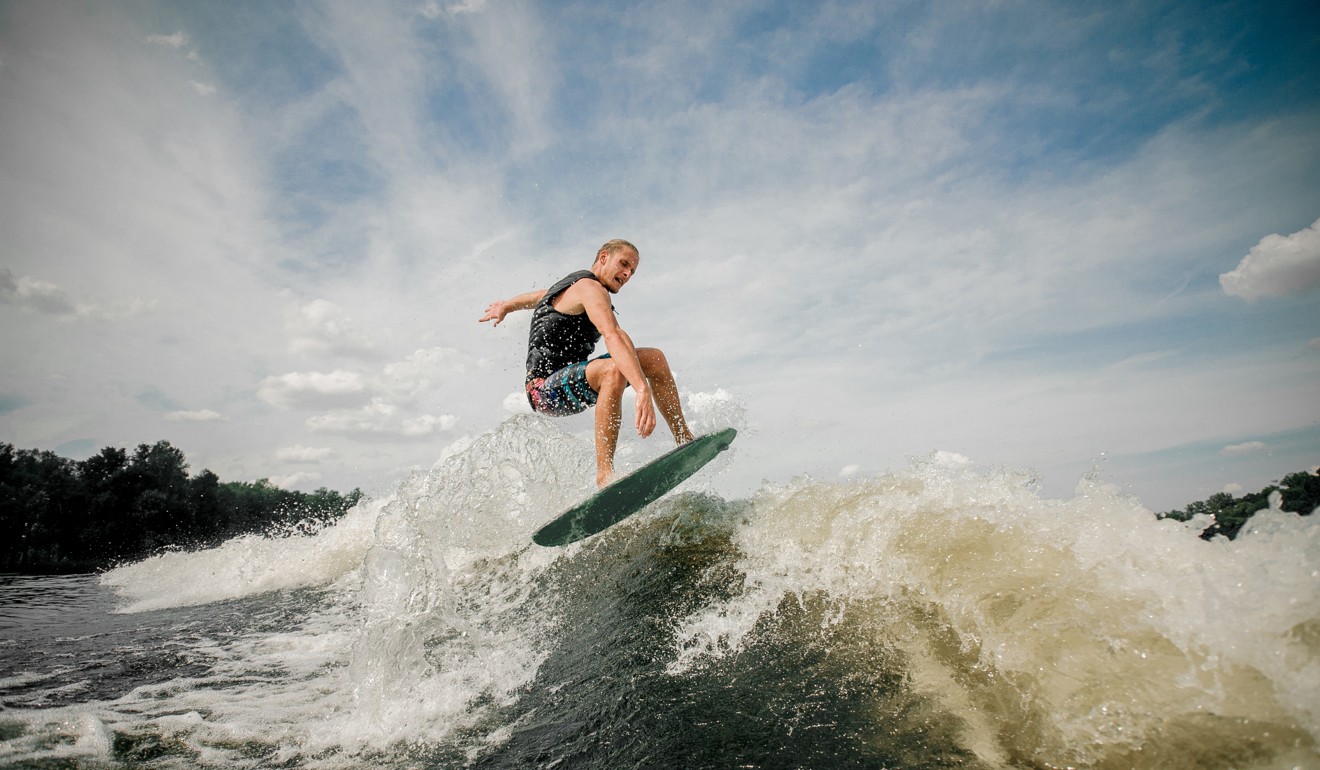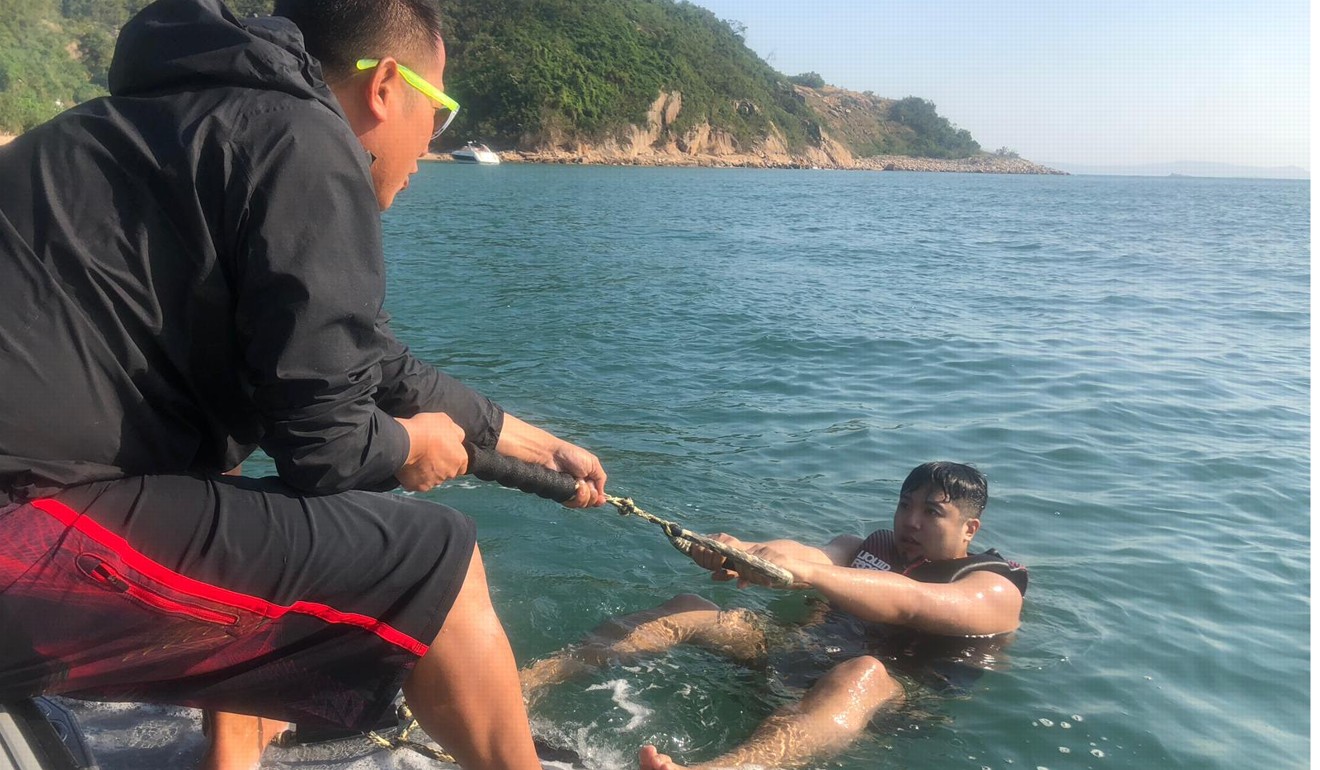
Wakesurfing – get in shape to master carving, ollies, shuvs, 720 spins and riding backside
- Riders use a rope to stand, but unlike wakeboarding, they let go of it and ride the wake. The sport puts less strain on the body than wakeboarding
- Models’ social media posts have ignited a craze for wakesurfing in Hong Kong
If you’re one of the many people who gave wakesurfing a try on a junk trip this summer and felt the thrill of riding a wave, now is the time to start getting serious.
In recent times, the sport has been gaining popularity as a less strenuous alternative to wakeboarding. But it’s now reached fever pitch, after celebrities and models started posting photos on social media of themselves riding waves off the back of speedboats, according to seasoned Hong Kong coaches.
Hong Kong Olympic committee plans bid to host 2021 World Beach Games
Similar to wakeboarding, in which the rider is pulled up onto the surface of the water using a tow rope, wakesurfing allows the rider, once stable, to toss the rope back into the boat and coast along the wave. The boat is generally weighted to one side so that the “surf” area is more substantial.
“The whole culture of wakesurfing changed this year,” says Kin Chu, a wakeboard and wakesurf instructor with Wakeboard.com.hk in Tai Tam. “It used to be a bunch of people who came to hang out in the sun, but now with the examples on social media, riders come with goals, like ‘How many sessions do I need to do to be able to carve, or do a 360 spin?’ Some even come with a photo they’ve seen, and ask me to teach them, so they can get the same shot.”

But how hard is it? Instructors say watersport novices are able to pick up the sport fairly quickly, while expert wakeboarders will be able to find new ways to challenge themselves.
The number of calories burned per hour-long session depends on the effort exerted. Someone simply coasting could burn as little as 150 to 200 calories a session, while those consistently executing a line-up of tricks could burn from 500 to 1,000 calories in the same period.
“Most people aren’t interested in it for keeping fit, although it is a cardio workout,” says Chu. “Your core is highly important for balance and your ability to control the direction of the board. Those with a background in yoga usually have an advantage, as they have a good sense of balance and they tend to be a bit more loose-limbed.”

Because of the high cost of the sport – between HK$1,000-$1,500 (US$130-$190) an hour, depending on the boat – few people will rely on it as their primary form of fitness.
Major water sports centre planned for Tseung Kwan O
The more expensive the session, in general, the better the boat, and the better the wake – so you’ll find the speedboats in popular wakeboarding locations such as Tai Tam and Tai Po have recently been upgraded, with instructors and private owners investing in the latest models from brands such as Nautique, Mastercraft and Moomba. These specialised boats allow the size and ferocity of the wake to be adjusted to the rider’s liking.
“With wakesurfing, the quality and size of the wake is much more important than in wakeboarding,” says Loretta Chan, a watersports enthusiast who made the switch from wakeboarding a couple of years ago. “In 2016 you’d see a lot of instructors trying to ‘hack’ their boats by weighing down one side with metal blocks, tanks of water or even extra people. The wakes weren’t great, but it was still fun.
“Without the toll that wakeboarding has on your body the next day, it was a natural switch for someone who’s getting a bit older, especially as you can learn tricks less dangerously with wakesurfing.”

According to Lee Shu-wai, an instructor and professional wakeboarder based in Tai Po, Hongkongers still have a long way to go before reaching the peak level of international riders.
“We’re still 40 or 50 per cent behind overseas riders. Resources here are limited and the area is small, so few people are able to get the amount of riding time necessary to be as good as international pros,” says Lee, who has trained competition-winning wakesurfers locally.
“To enter a competition in Hong Kong, you need to master carving, ollies, riding backside and being comfortable riding on either leg.” Search pro wakesurfers such as Ashley Kidd or Austin Keen on YouTube and you’ll find them flying in the air hitting 720-degree switches and 540 shuvs – names of tricky stunts.
As colder weather comes, Lee encourages serious riders to also practice on land: “Try tricks on a balance board such as an Indoboard, and focus on lower-body workouts, or else when spring comes, your mobility and stamina will be halved and you’ll need to play catch-up.”
Not everyone is in it for the competition, though. Model Nataliya Kovaleva wakesurfed for the first time at a friends’ birthday junk in 2016, and in the last year saw her Instagram following surge to almost 55,000 from posting videos of herself surfing.
How to reduce your plastic use from Hong Kong wakesurfer
“The first wave of followers came after a popular fitness Facebook group from Thailand reposted my [wakesurfing] video about a year ago. Half a year later, one of my videos went viral, boosting my following from around 15,000 to over 40,000 in less than a week,” she says.
While she has entered competitions, “I still consider it a hobby, as my goal isn’t to become a champion. I just want to develop my skills and prove to myself that I can keep up with the best. I receive a lot of exciting messages from people all over the world saying that they have tried wakesurfing because my videos inspired them. It makes me so happy. Wakesurfing is a great activity for the whole family, no matter the age.”

